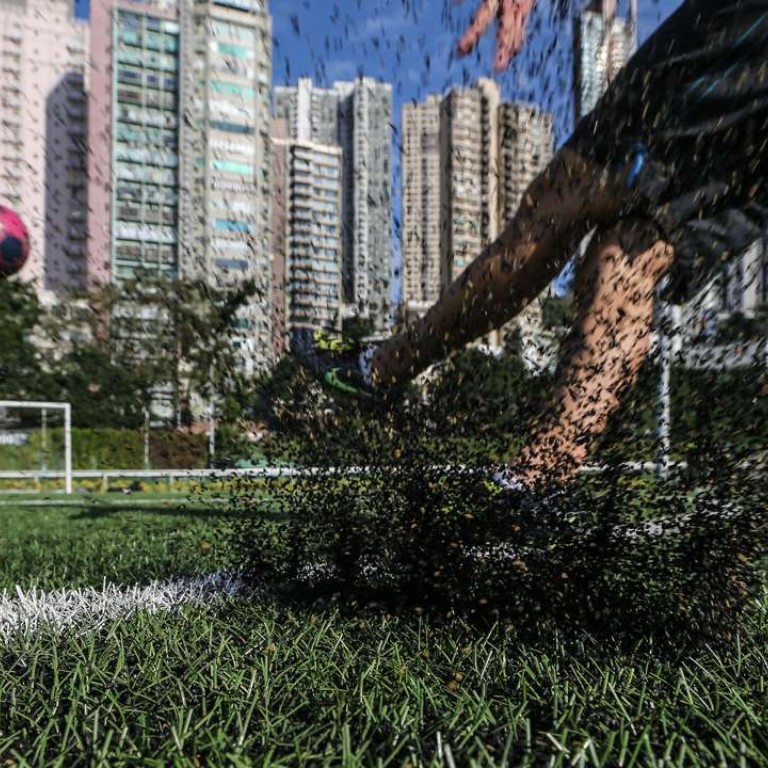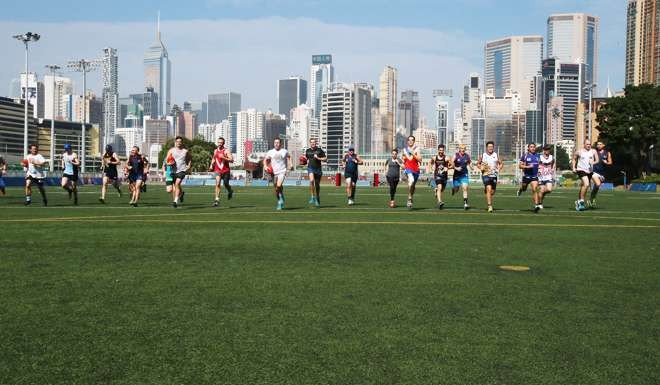
Health alert raised after tests on artificial turf reveal excess levels of toxic chemicals
Experts call for temporary closure of pitches or replacement with safer but more expensive material
Samples of artificial turf from two government pitches contained excessive levels of probable cancer-causing chemicals and heavy metals, according to laboratory test results obtained by the Post.
Experts who reviewed the test, commissioned by the Civic Party, called for a temporary closure of the pitches or the use of alternative materials. But they said further testing would be required to prove the extent of the risks posed to children.
The concern centres on chemicals used in the rubber granules – usually made from recycled tyres – which are used as filler material between plastic grass fibres in so-called third-generation pitches used by the Leisure and Cultural Services Department.

It is unclear what was tested as the ESF has refused to disclose its reports.
Six out of eight toxic chemicals listed as restricted under European Union regulations were found in two samples from Happy Valley Recreation Ground and Wong Chuk Hang Recreation Ground analysed by the Hong Kong Productivity Council.
The readings of polycyclic aromatic hydrocarbons (PAHs) – a group of chemicals usually released from burning coal, wood or in other manufacturing processes – ranged from 1.1 milligrams per kilogram to 15 mg/kg, exceeding permitted limits in consumer products under EU laws by up to 15 times.
Some of the eight restricted PAHs are known probable human carcinogens.

Three scientists the Post talked to agreed that high levels of toxic chemicals and heavy metals were potentially hazardous to human health, but they said the actual risk depended on how many chemicals were released.
“It’s obvious that the toxicity content is very high, but it really depends on how stable these compounds are. If the chemicals aren’t being released, then it’s safe,” Professor John Ho Wing-shing said.
With exposure to sunlight and water along with normal wear and tear, the surface of the rubber granules can be damaged, and toxic chemicals can be released to the environment.
Chemicals and heavy metals can be absorbed through skin contact and open wounds. Crumbs can also be worn down into dust small enough to inhale into the lungs, experts said.
Accumulation of such substances in the brain and other vital organs can lead to mental retardation and anaemia. Children are particularly at risk.
Experts added that there was no way to quantify how much would have to be absorbed before it posed a realistic cancer risk as it depended on frequency of exposure, damage to the rubber crumbs and how readily each person absorbed the chemicals.
There is no international consensus on the safety levels of artificial turf pitches, neither is it proven that toxic chemicals in the rubber granules can cause cancer. Reports of possible links between turf materials and cancer have prompted calls worldwide for more detailed research.
The United States Environmental Protection Agency had recently backtracked on a study that said the rubber crumbs warranted a “ low level of concern”, and relaunched an investigation into the issue.
In response to the Post’s inquiries, an LCSD spokesman played down the findings, saying initial observations suggested the test report lacked essential information, such as sample preparation procedures and compliance with relevant standards.

It stressed that all 3G pitches complied with the standards of Fifa, football’s world governing body, which state that turf materials must be non-toxic. The department was studying the report and would post hygiene notices at all its pitches.
The LCSD has been swapping real grass for artificial since 2004 to boost usage and reduce costs. It now manages 43 natural pitches and 38 artificial.
These kind of levels ... I suspect are as high as those in toxic waste
Professor Chan King-ming, who heads Chinese University’s environmental science programme, said the LCSD had a responsibility to close the pitches and conduct tests to determine the degree to which the chemicals were being leached into the environment.
“These kind of levels ... I suspect are as high as those in toxic waste, but we need to know where the turf is produced and what materials they are composed of,” Chan said.
Ho suggested the government should use alternative materials – such as heavy metal-free rubber or coconut fibres – that are safer but more expensive.
However, Dr Chung Shan-shan, who heads Baptist University’s Environmental and Public Health Programme, raised questions about the sampling method used as it could not rule out that the toxic chemicals were from dust in the environment.

People can be exposed to PAHs in the air they breathe as vehicle emissions and cigarette smoke also contain such chemicals.
“Unless the sample preparation process eliminated all the non-targeted materials, it is not known if the test results reflect the turf material only,” Chung said. The test samples were not washed by the lab before they were analysed.
Civic Party lawmaker Tanya Chan, who commissioned the test, understood there were limitations but pointed out that even if the test results included dust among the rubber crumbs, it was also part of what children would be exposed to.


